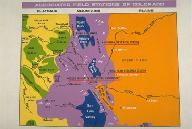
The Effects of Nitrogen on Biodiversity at Niwot Ridge
 |
| Location of Niwot Ridge Click for larger image |

 |
| Location of Niwot Ridge Click for larger image |
by Susanna French
The haze is thick in Denver on this broiling day in June. But west of Boulder, atop 11,500-foot Niwot Ridge, it is cool and bright beneath an achingly blue sky. Gray peaks surround the ridge, which is carpeted with tiny alpine plants. Wildflower season has scattered all shades of purple, yellow, pink and blue like confetti among new leaves. The dirty remnants of the snowpack, still quite deep in places, keep a chill on the wind. The silence of the tundra is startling. No car horns, no barking dogs. Just a distilled quiet where all is still.
Or so it seems. Beneath the tundra, life is surprisingly busy. Plants are growing faster than ever recorded, and microbes are thriving from an overabundance of nutrients falling from the sky.
This may seem like good news, but its not. Carried on the wind and in the snow, nitrogen in air pollution has deceived tundra life into a false sense of prosperity. The nitrogen, which comes from cars, power plants, and agriculture, has been accumulating in recent years at a rate four times that first measured in the late 1970s. If scientists studying the phenomenon are right, it can't keep doing so much longer. On Niwot Ridge, in nearby Rocky Mountain National Park, and in other high-altitude ecosystems in Colorado, nature is nearing the threshold of its ability to take up all the extra nitrogen it is receiving. If that threshold is passed, nitrogen will leach nutrients from the soil, threaten fragile tundra plants, and poison rivers and streams.
Tundra plants are growing fast, but the Front Range is growing faster. According to the Colorado Department of Transportation, TK more cars are driving Colorado's roads than in 1970, and that number is expected to increase by TK percent by the end of the century. This means that nature is moving ever quicker to its nitrogen limit, there's no cure in sight. The buildup of pollution will accelerate as Colorado continues to grow.
But nitrogen studies are so new to environmental science that researchers are just beginning to understand the pollution's impact on the ecosystem of the Niwot Ridge. Tim Seastedt at the University of Colorado's Institute of Arctic and Alpine Research (INSTAAR) is working with colleagues to answer some of the broad and complex questions nitrogen pollution raises. While pollution's long-term consequences are unknown, researchers are certain that too much nitrogen upsets the natural balance, both at Niwot Ridge and around the world. "It's causing wholesale changes," Seastedt says.
Before man came along, nitrogen acted like a speed limit in nature. An ingredient of enzymes and amino acids, it was only available to plants when lightning liberated it from the atmosphere or when microbes altered it in the soil. There was never too much of the stuff, and this low supply kept growth in check. Plants adapted to nitrogen's scarcity by recycling it, or by forming partnerships with microbes that got it for them.
But since the industrial age, humans have profoundly altered the nitrogen cycle by burning fossil fuels and applying nitrogen fertilizers to agricultural lands to stimulate crop growth.